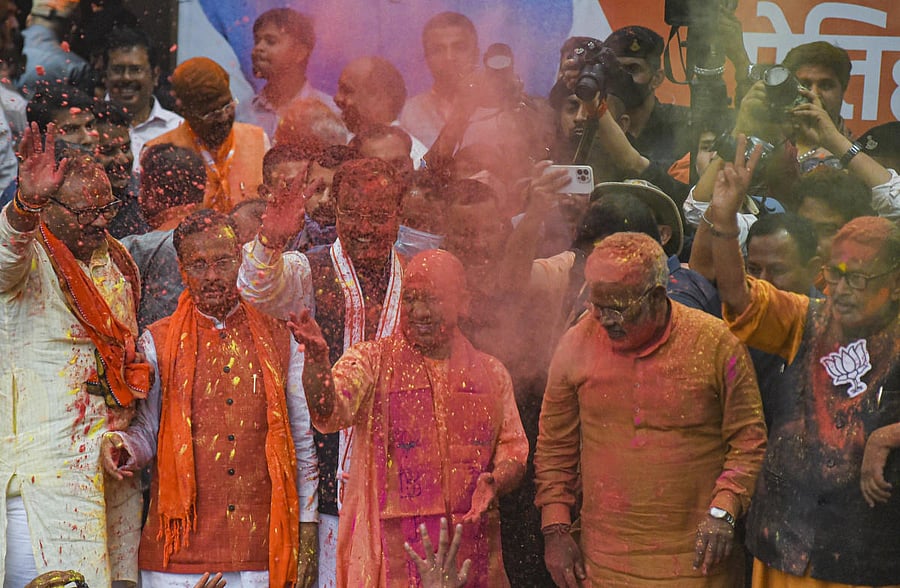The results of the five state legislatures are what they are – a robust victory for the BJP. This is especially so in Uttar Pradesh, which carries immense weight in national politics, contributing 80 MPs to Parliament. It is quite clear that the BJP will form the government in four out of the five states that went to polls.
The results in UP have proved wrong the prevailing common wisdom that the party was in a tough spot. In adjoining Uttarakhand, despite three non-performing chief ministers in five years, the gap between the BJP and the main Opposition, the Congress party, has gone up. The BJP has not faced a credible challenge anywhere. In Punjab, the challenge of AAP was to the incumbent Congress and not to the BJP. And in Manipur and Goa, where it was thought that the party might need to break rival parties, it looks like that may not be necessary this time around.
Breast-beating till the cows come home and analysing the election outcomes based on caste and other factors may not be a productive activity for anyone except the losing parties. The more important issue is what these results portend for the future of Indian politics.
The election results have confirmed the unquestioned popular acceptance of Prime Minister Narendra Modi. He has demonstrated time and again that peoples’ grievances, farmers’ protests, unemployment, price rise and blatant corporate cronyism makes no difference to winning elections. He holds a monopoly over the political discourse in the country. The political narrative he sets need not have anything to do with any real issues that the nation faces, including peoples’ livelihoods. Communalism plus welfarism, based on freebies, seems to work for him time and time again, with or without economic growth. Voters do not respond to rational arguments or think strategically about their future as they respond fulsomely to a web of demagoguery spun with emotive notions of nationalism, national security and communalism.
These election results also put an end to any putative challenge to Modi’s leadership from within the party. Yogi Adityanath may well be chastened now as the slide in the party’s legislative strength from 2017 to 2022 would be seen as his doing. It will temper his adversarial attitude towards the central leadership of the BJP, especially if the Centre once again sponsors him as Chief Minister, as it did in 2017.
The victory also demonstrates once again that no other party can match the BJP’s election management and tactics under the Modi-Amit Shah duo. Other political parties try to sway the public mood by raising issues that they think matter to the voters. The BJP on the other hand itself decides what should matter to the masses, hijab in some phases of the UP election and the Opposition as “terrorist supporters” and “mafiawadi” in others. It also micro-manages how voters exercise their choices through highly effective booth management.
In addition, opaque electoral bonds have ensured that the party has a monopoly over resources, while other sources of funds for the Opposition are choked off by policies such as demonetisation in 2016 and setting government agencies after their potential financiers. Its deep pockets can be used for horse-trading if there is a hung Assembly. This formidable electoral juggernaut has allowed the BJP to retain power despite the economy being in the doldrums, unemployment rising, prices skyrocketing and social harmony in tatters.
For the national Opposition, these election results, especially in UP, have sounded the death knell. In 2014, the Modi victory had decimated the Congress and reduced the Opposition to merely a tactical and reactive entity. In 2021, the victory of Mamata Banerjee’s Trinamool Congress had led to embryonic hopes that it was possible to defeat the Modi machine and that if only anti-BJP regional parties came together, this would become possible. These hopes have been dashed in a state which enjoys the highest political weight in the country.
The AAP challenge in Punjab became successful only because of a favourable conjuncture, given the anti-incumbency against the Congress, its change of Chief Minister mid-stream for garnering caste-based votes, and the perceived unviability of the Shiromani Akali Dal, which had broken its alliance with the BJP. It is doubtful whether any crystallisation of Opposition forces will take place around AAP and its ambitious leader Arvind Kejriwal, who wants to occupy the same political space as the BJP by toning down, but not abandoning, communalism. In the short run, the AAP will be a challenge for the BJP in Gujarat, now that it would have greater access to resources and the tailwinds of the Punjab victory propelling it forward. It already has a foothold there in the Surat municipality as the main Opposition.
When Parliament resumes its current session, the BJP is likely to become even more aggressive. The last throes of the Opposition will also become evident in July this year, when the Presidential election is due. The national political narrative will go even more firmly into the hands of the BJP and Prime Minister Modi will control it unchallenged. People have shown an eagerness to accept whatever he says, even if some of his statements are prima facie incredulous. No one in the Opposition has managed to set up an alternative credible agenda. Equally, one might wonder what such an agenda might be if economic issues do not matter to the people. The BJP’s communal narrative too seems to have found total acceptance with the majority. It seems the doors to political change in 2024 may be shutting on the Opposition.
It seems that the BJP has put the nation in a state where long-term misery and electoral victories go hand in hand – the farmers can continue to agitate, unemployment can increase, prices can touch the roof, but no one can touch the BJP and its election victories.
